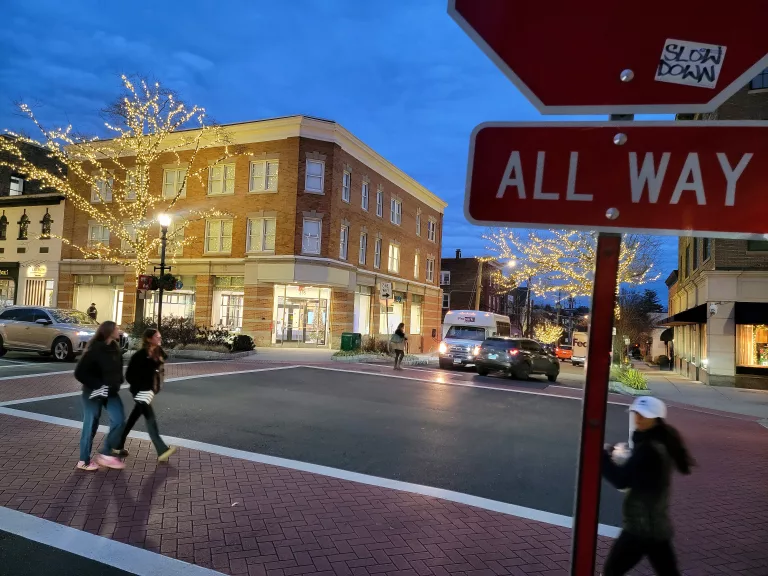
By Fred Wu
At the February 16 meeting of the Retired Men’s Association, Hollister Sturges introduced State Representative Steve Meskers of the 150th District in Connecticut. Steve identifies himself as a fiscally conservative, socially progressive Democrat. He was elected in November 2018, the first Democrat elected from the district in over 100 years, and has just completed the first year of his second term. Steve spoke about the current state of the Connecticut economy and what the state government is doing to ensure a bright future.
According to Meskers, Connecticut has made significant progress since the budget impasse in 2017. Three consecutive fiscal years have closed in surplus and the state has the most robust Budget Reserve Fund in its history. The state has reduced unfunded liabilities by making more than $1.6 billion in supplemental pension payments on top of the annual payments. The state’s credit rating was upgraded for the first time in 20 years.
Continuing Connecticut’s recent run of financial successes is dependent on remaining disciplined. It cannot be presumed that the pandemic is over. Further, it is not until the FY 2024–2025 biennium that the gap between the growth in fixed costs versus revenue begins to narrow. While large surpluses are projected for fiscal years 2022 and 2023, this business cycle will inevitably slow. The state needs to be prepared by continuing to be prudent stewards of the its resources.
The state’s fiscal position at the end of FY 2021 was much better than envisioned at the start of the COVID-19 pandemic. FY 2021 ended with a General Fund surplus of $475.9 million, the third consecutive year-end surplus. In addition, the state was able to maintain budgetary reserves at 15% while paying down unfunded liabilities. This success can be attributed to the effective response to the COVID-19 public health crisis which minimized disruption to most economic sectors and encouraged in-migration of residents and businesses, the unprecedented level of federal economic stimulus, and finally, the state’s budgetary discipline. Considering the above, the governor is proposing modest, but impactful, revisions to the state’s tax policies.
First, to provide meaningful middle-class tax relief and increase equity in the taxation of automobiles across the state, the governor is proposing to lower the existing property tax cap of 45 mills on automobiles to 29 mills. Towns would be reimbursed for the lower cap, at an expected cost of $160.4 million annually.
Second, to stem the outflow of retirees, the governor is proposing to accelerate the phase-in of the pensions and annuities income tax exemption by three years. This provision allows single filers with an adjusted gross income (AGI) of less than $75,000 or joint filers with an AGI of less than $100,000 to exempt 100% of their pension and annuity income from the state income tax, up from the original 56%.
Third, the governor is also proposing to accelerate the restoration of the property tax credit on income tax to full eligibility while increasing the maximum credit amount from $200 to $300. Currently, only filers age 65 and over or those with dependents are eligible for the property tax credit. This is expected to double the current 400,000 eligible filers.
Fourth, to help attract educated younger workers to the state while helping to ameliorate the student loan debt burden, the governor is proposing to expand the employer student loan tax credit. Businesses that contribute toward an employee’s student loan balance can avail themselves of a 50% tax credit up to $2,625 per employee per income year. In sum, the tax relief proposals contained in this budget would total $335.7 million.
In the Q&A session that followed, Steve addressed many other important economic issues, including the shortage of affordable housing, the continuing high level of state government indebtedness, the great need for transportation infrastructure improvements, and the financial stress facing non-profit organizations unable to keep pace with private sector wage increases.
To watch Steve Meskers’ presentation, click here (https://vimeo.com/679541417).
The RMA’s upcoming presentation “Puppetry as an Art Form – The Legacy of Jim Henson” by Leslee Asch is scheduled for 11 AM on Wednesday, March 2. Ms. Asch worked for Jim Henson for over 20 years, and has written a book “Out of the Shadows: The Henson Festivals and Their Impact on Contemporary Puppet Theater.” Her book is the first to focus solely on Jim Henson’s love of, and impact on puppetry as a vital contemporary art form. The author will highlight some of the important connections Connecticut and Greenwich have to this ancient and yet continually evolving art form. The University of Connecticut, since 1965, has been conferring undergraduate and graduate degrees in puppetry, through its Ballard Institute and Museum of Puppetry.
To stream Ms. Asch’s presentation at 11 AM on Wednesday, March 2, click here (https://bit.ly/30IBj21). This presentation will also be available on local public access TV Channels, Verizon FIOS channel 24 and Optimum (Cablevision) channel 79.
RMA speaker presentations are presented as a community service at no cost to in-person or Zoom attendees. The RMA urges all eligible individuals to consider becoming a member of our great organization, and thereby enjoy all the available fellowship, volunteer, and community service opportunities which the RMA offers to its members. For further information, contact Michael Ambrosino (mailto:brooklynoil@ yahoo.com) or Peter Stern (mailto:pmstern@optonline.net).





